1993 CHEVROLET LUMINA power steering
[x] Cancel search: power steeringPage 50 of 324
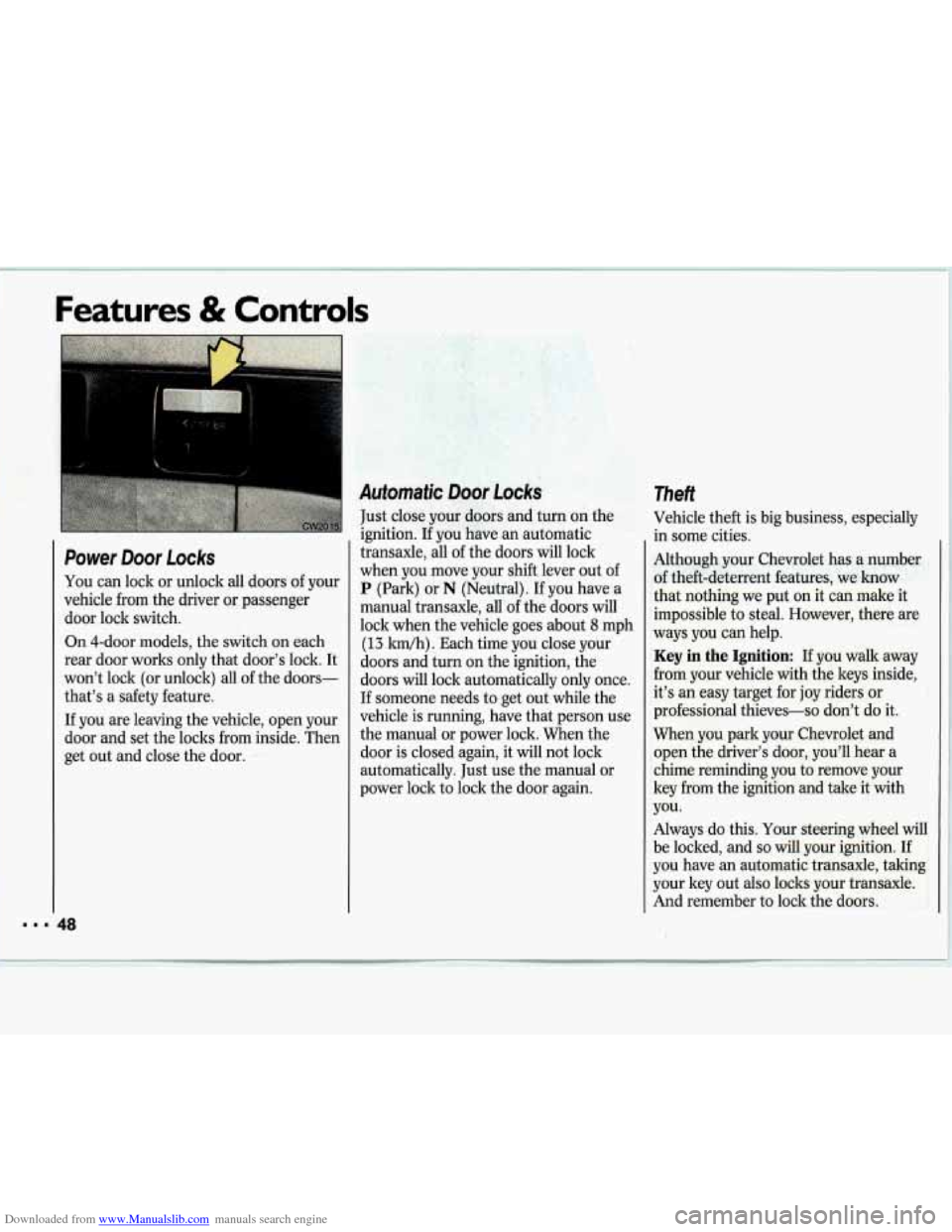
Downloaded from www.Manualslib.com manuals search engine Features & Controls
Power Door Locks
You can lock or unlock all doors of your
vehicle from the driver or passenger
door lock switch.
On 4-door models, the switch on each
rear door worlts only that door’s lock. It
won’t lock (or unlock) all of the doors-
that’s a safety feature.
If you are leaving the vehicle, open your
door and set the locks from inside. Then
get out and close the door.
Automatic Door Locks
Just close your doors and turn on the
ignition. If you have an automatic
transaxle, all of the doors will lock
when you move your shift lever out of
P (Park) or N (Neutral). If you have a
manual transaxle, all of the doors will
lock when the vehicle goes about
8 mph
(13 lun/h) . Each time you close your
doors and turn on the ignition, the
doors will lock automatically only once.
If someone needs to get out while the
vehicle is running, have that person use
the manual or power lock. When the
door is closed again, it will not lock
automatically. Just use the manual or
power lock to lock the door again.
Theft
Vehicle theft is big business, especially
in some cities.
Although your Chevrolet has a number of theft-deterrent features, we know
that nothing we put on it can make it
impossible to steal. However, there are
ways you can help.
Key in the Ignition: If you walk away
from your vehicle with the keys inside,
it’s an easy target for joy riders or
professional thieves-so don’t do it.
When you park your Chevrolet and open the driver’s door, you’ll hear a
chime reminding you to remove your
key from the ignition and take it with
you.
Always do this. Your steering wheel will
be locked, and
so will your ignition. If
you have an automatic transaxle, taking
your key out also locks your transaxle.
And remember to lock the doors.
Page 53 of 324

Downloaded from www.Manualslib.com manuals search engine New Vehicle “Break-ln”
/gnition Switch
With the ignition key in the ignition
switch, you can turn the switch to five
positions:
Accessory: An “on” position in which
you can operate your radio and
windshield wipers. Press in the ignition
switch as you turn the top
of it toward
you.
Lock The only position in which you
can remove the key. This locks your
steering wheel, ignition and transaxle.
I
Off: Unlocks the steering wheel,
ignition, and transaxle, but does not
send electrical power to any accessories.
Use this position if your vehicle must be
pushed or towed, but never try to push-
start your vehicle. A warning chime will
sound
if you open the driver’s door
when the ignition is
off and the key is in
the ignition.
Run: An “on” position to which the
switch returns after you start your
engine and release the switch. The
switch stays in the
Run position when
the engine is running. But even when
the engine is not running, you can use
Run to operate your electrical power
accessories, and to display some instru-
ment panel warning lights.
Page 71 of 324
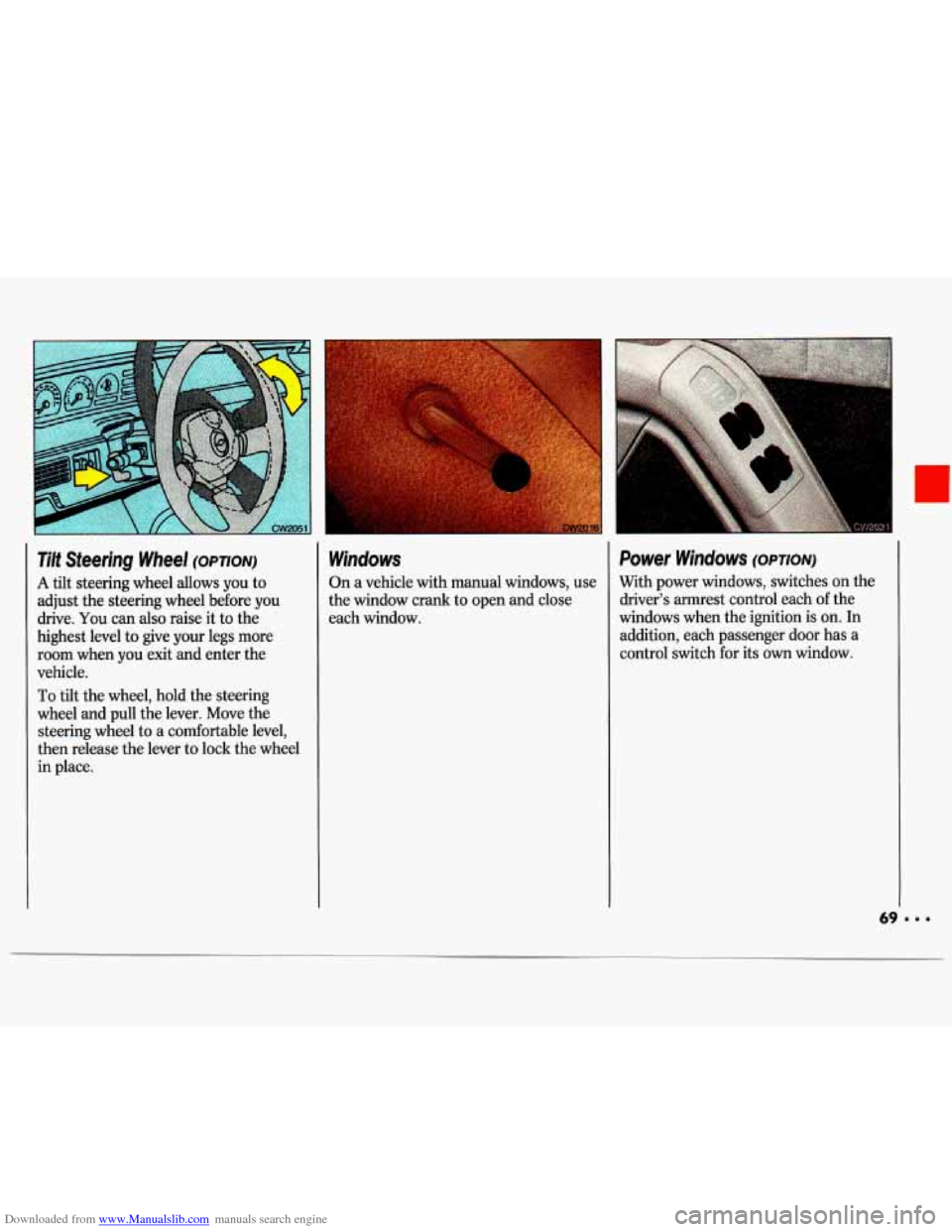
Downloaded from www.Manualslib.com manuals search engine Tilt Steering Wheel (OPTION)
A tilt steering wheel allows you to
adjust the steering wheel before
you
drive. You can also raise it to the
highest level to give
your legs more
room when
you exit and enter the
vehicle.
To tilt the wheel, hold the steering
wheel and pull the lever. Move the
steering wheel to a comfortable level,
then release the lever to lock the wheel
in place.
Windows
On a vehicle with manual windows, use
the window crank to open and close
each window.
Power Windows (OPTION)
With power windows, switches on the
driver’s armrest control each of the
windows when the ignition is on.
In
addition, each passenger door has a
control switch for its
own window.
Page 133 of 324
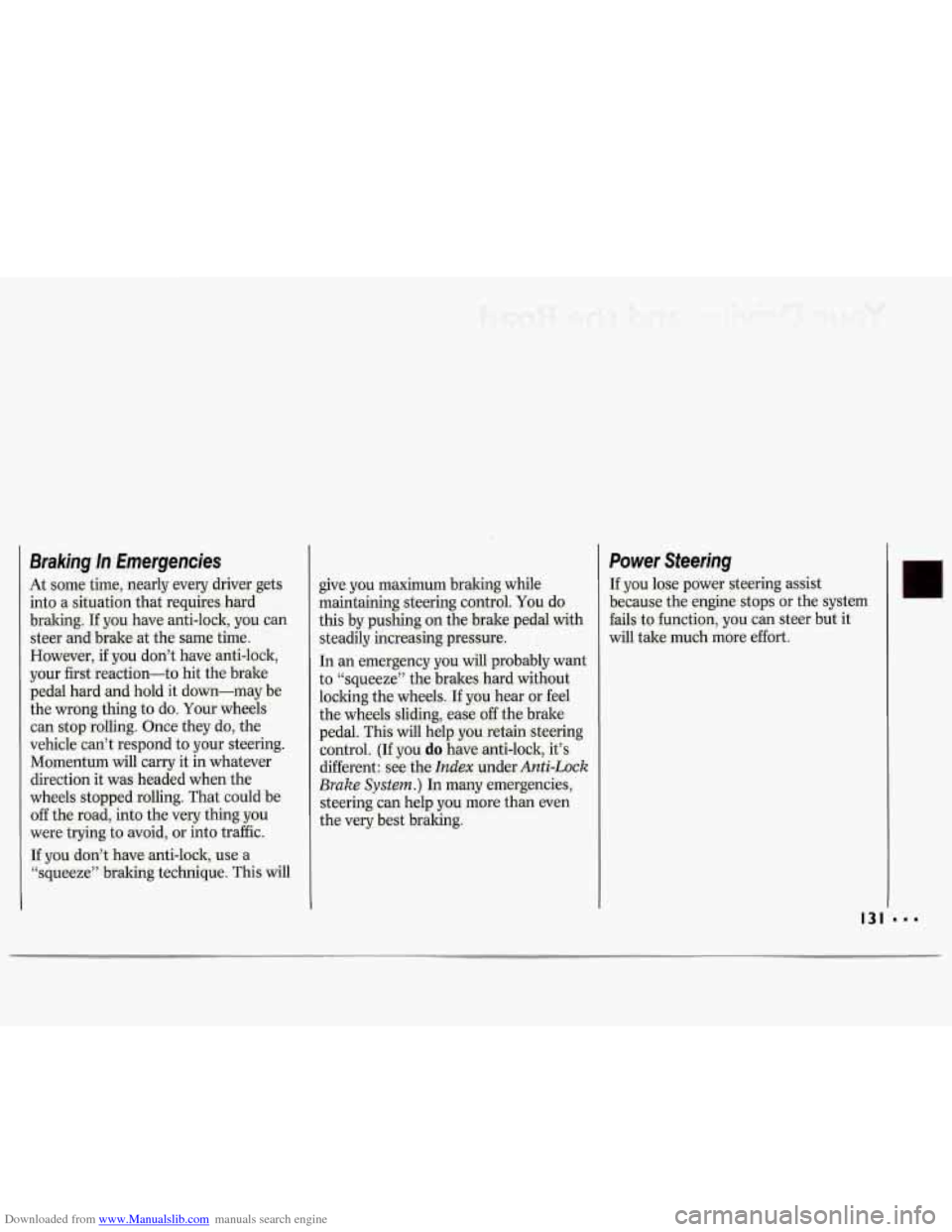
Downloaded from www.Manualslib.com manuals search engine Braking In Emergencies
At some time, nearly every driver gets into a situation that requires hard
braking.
If you have anti-lock, you can
steer and brake at the same time.
However, if you don’t have anti-lock,
your first reaction-to hit the brake
pedal hard and hold it down-may be
the wrong thing to do. Your wheels
can stop rolling. Once they
do, the
vehicle can’t respond to your steering.
Momentum will carry it in whatever
direction it was headed when the
wheels stopped rolling. That could be off the road, into the very thing you
were trying to avoid, or into traffic.
If you don’t have anti-lock, use a
“squeeze” braking technique. This will give you maximum braking while
maintaining steering control.
You do
this by pushing
on the brake pedal with
steadily increasing pressure.
In an emergency you will probably want
to “squeeze” the brakes hard without
locking the wheels. If you hear or feel
the wheels sliding, ease
off the brake
pedal. This will help you retain steering
control.
(If you do have anti-lock, it’s
different: see the
Index under Anti-Lock
Brake System.)
In many emergencies,
steering can help you more than even
the very best braking.
Power Steering
If you lose power steering assist
because the engine stops or the system
fails to function, you can steer but it
will take much more effort.
Page 193 of 324

Downloaded from www.Manualslib.com manuals search engine H ere you will find information
about the care of your Chevrolet
.
This part begins with service and
fuel information. and then it shows how to check important fluid and
lubricant levels
. There is also
technical information about your
vehicle. and a section devoted to its
appearance care
.
part 6
Service & Appearance Care
Service ........................................................................\
............................................. 192
Fuel
........................................................................\
.................................................. 193
Hood Release ........................................................................\
................................... 196
Engine Oil ........................................................................\
....................................... 201
Air Cleaner ........................................................................\
...................................... 205
Transaxle Fluid
........................................................................\
................................ 206
Engine Coolant
........................................................................\
................................ 211
Power Steering Fluid
........................................................................\
....................... 214
Windshield Washer Fluid
........................................................................\
................ 215
Brakes
........................................................................\
.............................................. 216
Battery
........................................................................\
............................................. 218
Bulb Replacement
........................................................................\
............................ 218
Windshield Wiper Blade Replacement
.................................................................... 224
Loading Your Vehicle
........................................................................\
...................... 224
Tires
........................................................................\
................................................. 225
Appearance Care
........................................................................\
............................. 232
Vehicle Identification Number (VIN)
.................................................................... 239
Add-on Electrical Equipment
........................................................................\
........ 240
Fuses
& Circuit Breakers ........................................................................\
............... 241
Capacities and Specifications 247
Fluids
& Lubricants ........................................................................\
........................ 249
Replacement Bulbs
........................................................................\
......................... 251
Normal Maintenance Replacement Parts
.............................................................. 254
.. ........................................................................\
..........
Page 200 of 324
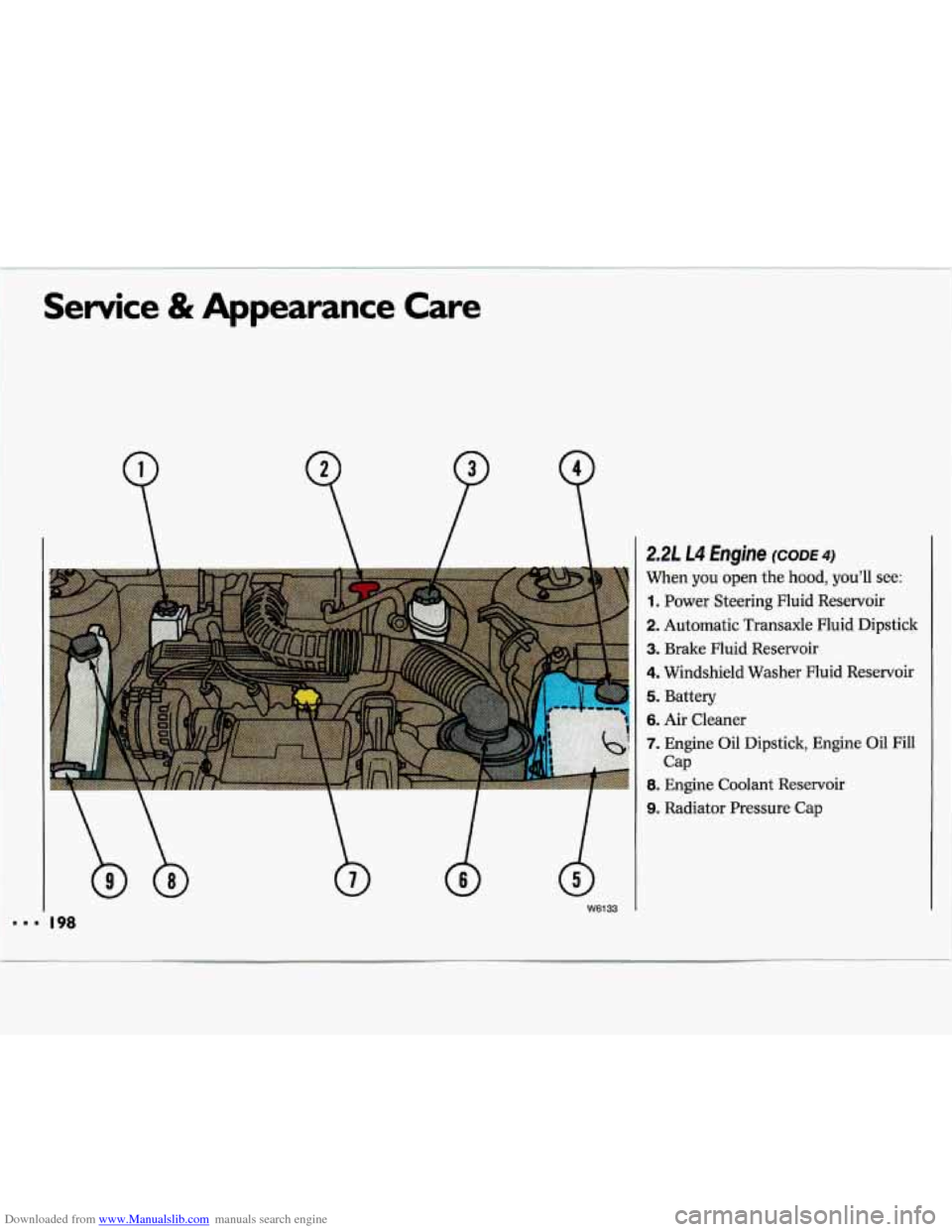
Downloaded from www.Manualslib.com manuals search engine Service & Appearance Care
9 P
. I ...... 2.2L L4 €ngine (CODE 4)
When you open the hood, you’ll see:
1. Power Steering Fluid Reservoir
2. Automatic Transaxle Fluid Dipstick
3. Brake Fluid Reservoir
4. Windshield Washer Fluid Reservoir
..............
b
I
9. Radiator Pressure Cap
W6133 I
Page 201 of 324
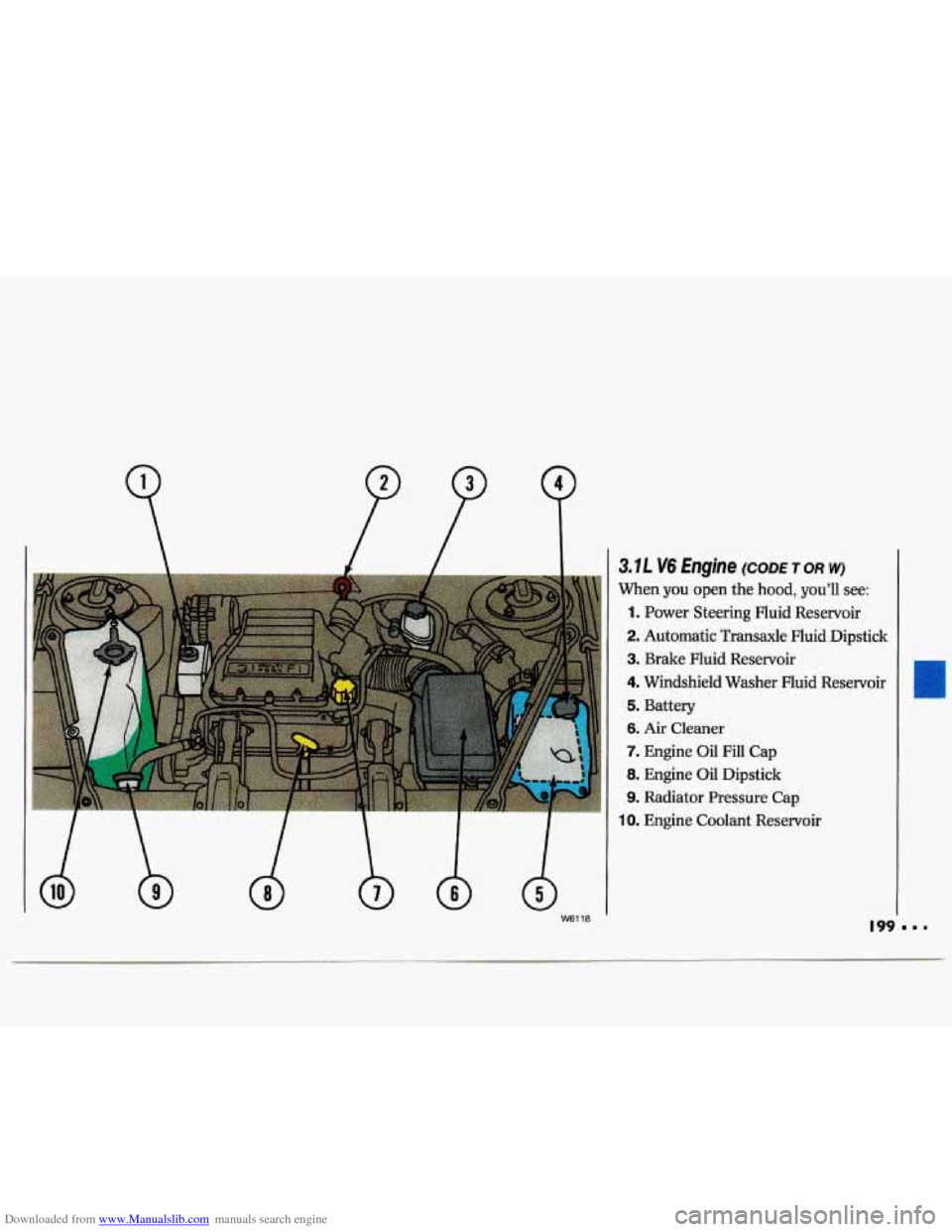
Downloaded from www.Manualslib.com manuals search engine 3.7L V6 Engine (CODE TOR w)
When you open the hood, you’ll see:
1. Power Steering Fluid Reservoir
2. Automatic Transaxle Fluid Dipstick
3. Brake Fluid Reservoir
4. Windshield Washer Fluid Reservoir
5. Battery
6. Air Cleaner
7. Engine Oil Fill Cap
8. Engine Oil Dipstick
9. Radiator Pressure Cap
10. Engine Coolant Reservoir
I99
Page 202 of 324
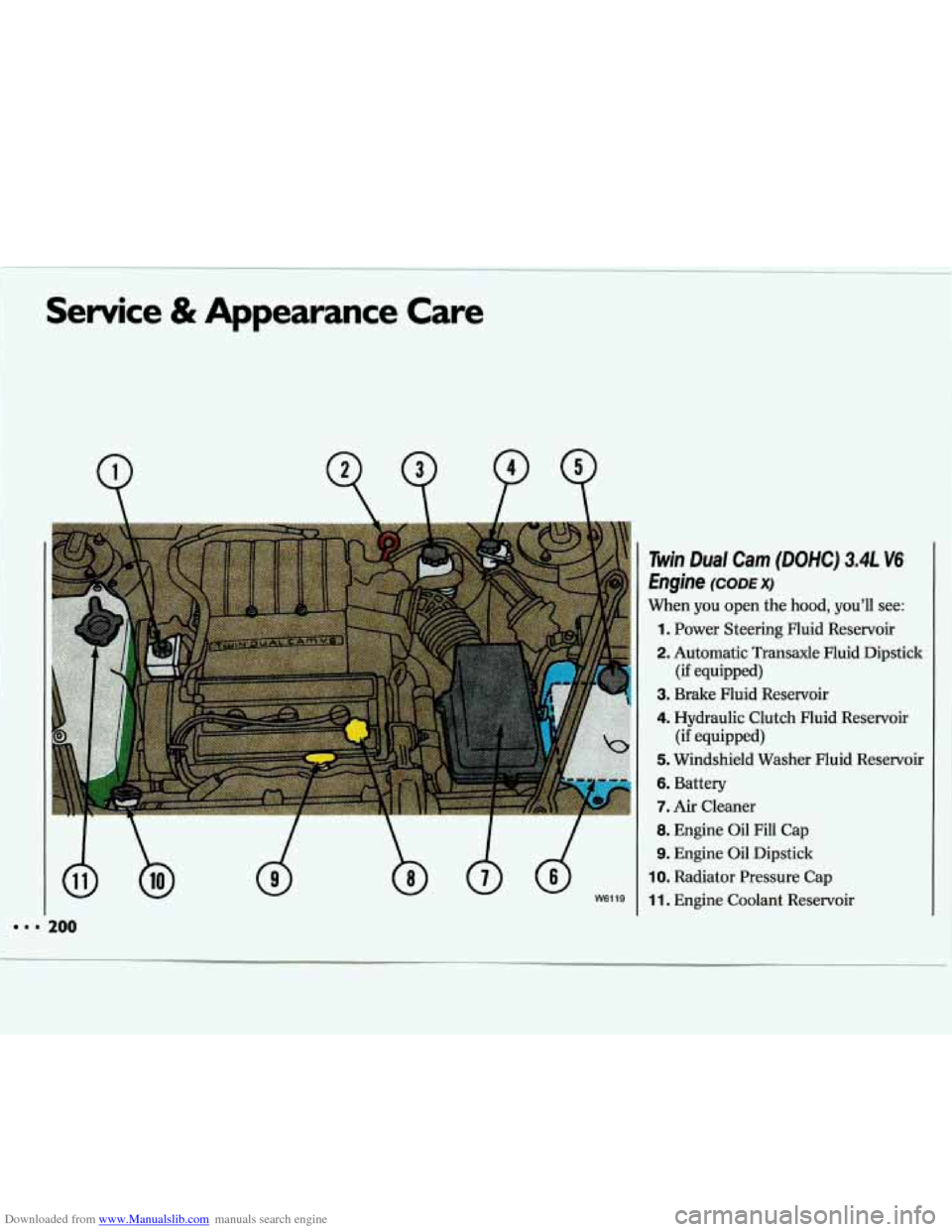
Downloaded from www.Manualslib.com manuals search engine Service & Appearance Care
= 200
W6119
Twin Dual Cam (DOHC) 3.4L V6
Engine (CODE X)
When you open the hood, you’ll see:
1. Power Steering Fluid Reservoir
2. Automatic Transaxle Fluid Dipstick
3. Brake Fluid Reservoir
4. Hydraulic Clutch Fluid Reservoir
5. Windshield Washer Fluid Reservoir
6. Battery
7. Air Cleaner
8. Engine Oil Fill Cap
9. Engine Oil Dipstick
IO. Radiator Pressure Cap
11. Engine Coolant Reservoir
(if equipped)
(if equipped)